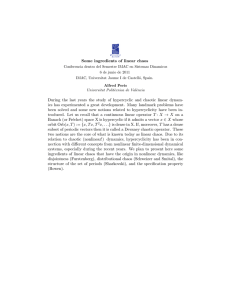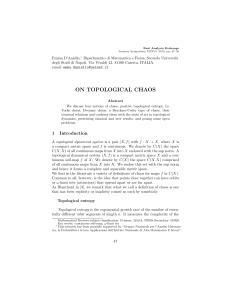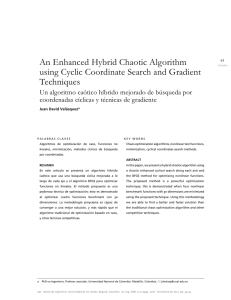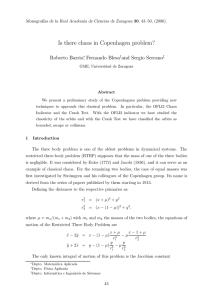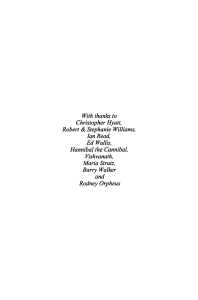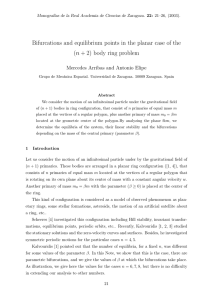Descargar este archivo PDF
Anuncio
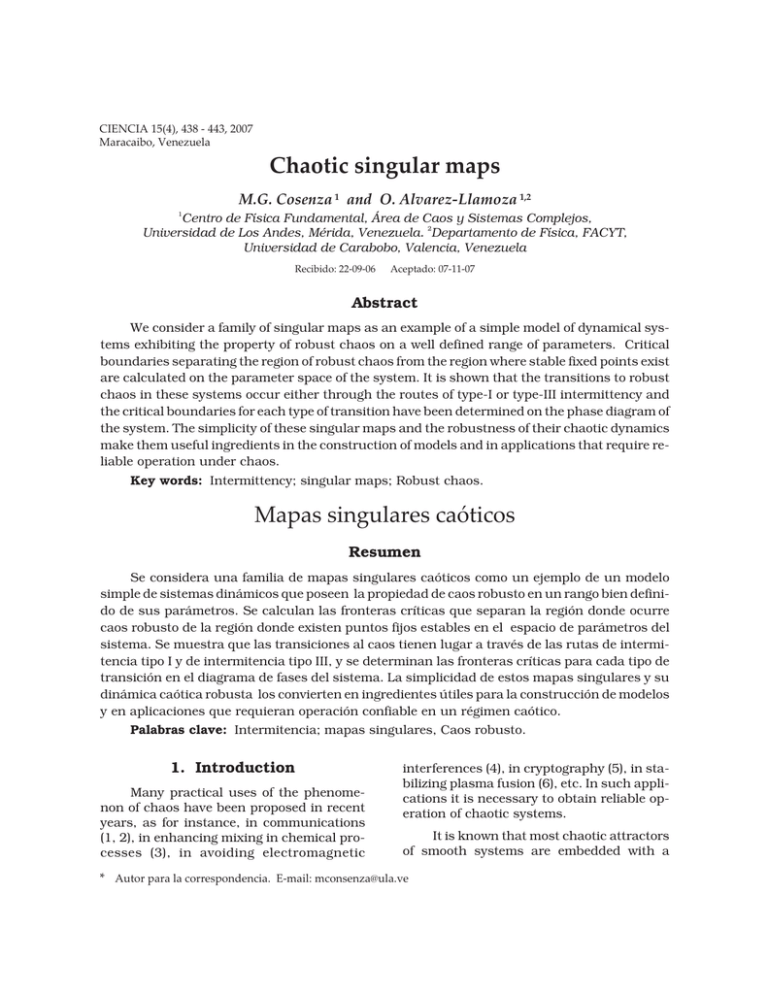
CIENCIA 15(4), 438 - 443, 2007 Maracaibo, Venezuela Chaotic singular maps M.G. Cosenza 1 and O. Alvarez-Llamoza 1,2 1 Centro de Física Fundamental, Área de Caos y Sistemas Complejos, Universidad de Los Andes, Mérida, Venezuela. 2Departamento de Física, FACYT, Universidad de Carabobo, Valencia, Venezuela Recibido: 22-09-06 Aceptado: 07-11-07 Abstract We consider a family of singular maps as an example of a simple model of dynamical systems exhibiting the property of robust chaos on a well defined range of parameters. Critical boundaries separating the region of robust chaos from the region where stable fixed points exist are calculated on the parameter space of the system. It is shown that the transitions to robust chaos in these systems occur either through the routes of type-I or type-III intermittency and the critical boundaries for each type of transition have been determined on the phase diagram of the system. The simplicity of these singular maps and the robustness of their chaotic dynamics make them useful ingredients in the construction of models and in applications that require reliable operation under chaos. Key words: Intermittency; singular maps; Robust chaos. Mapas singulares caóticos Resumen Se considera una familia de mapas singulares caóticos como un ejemplo de un modelo simple de sistemas dinámicos que poseen la propiedad de caos robusto en un rango bien definido de sus parámetros. Se calculan las fronteras críticas que separan la región donde ocurre caos robusto de la región donde existen puntos fijos estables en el espacio de parámetros del sistema. Se muestra que las transiciones al caos tienen lugar a través de las rutas de intermitencia tipo I y de intermitencia tipo III, y se determinan las fronteras críticas para cada tipo de transición en el diagrama de fases del sistema. La simplicidad de estos mapas singulares y su dinámica caótica robusta los convierten en ingredientes útiles para la construcción de modelos y en aplicaciones que requieran operación confiable en un régimen caótico. Palabras clave: Intermitencia; mapas singulares, Caos robusto. 1. Introduction Many practical uses of the phenomenon of chaos have been proposed in recent years, as for instance, in communications (1, 2), in enhancing mixing in chemical processes (3), in avoid ing elec tro mag netic interferences (4), in cryptography (5), in stabilizing plasma fusion (6), etc. In such applications it is necessary to obtain reliable operation of chaotic systems. It is known that most chaotic attractors of smooth systems are embedded with a * Autor para la correspondencia. E-mail: [email protected] M.G. Cosenza et al. / Ciencia Vol. 15, Nº 4 (2007) 438 - 443 dense set of periodic windows for any range of parameter values. Therefore in practical systems functioning in chaotic mode, a slight fluctuation of a parameter may drive the system out of chaos. On the other hand, it has been shown that some dynamical systems can exhibit robust chaos (7-9). A chaotic attractor is said to be robust if, for its parameter values, there exist a neighborhood in the parameter space with absence of periodic windows and the chaotic attractor is unique (7). Robustness is an important property in applications that require reliable operation under chaos in the sense that the chaotic behavior cannot be destroyed by arbitrarily small perturbations of the system parameters. For example, robust chaos has ef ficiently been used in communications schemes (10). In this article we study a family of singular maps as an example of a simple model of dynamical systems that shows robust chaos on a finite interval of their parameter values. In Section 2 we introduce this family of maps and investigate their dynamical properties, both analytically and numerically. It is found that the transitions to robust chaos in these systems occur either through the routes of type-I or type-III intermittency (11). The region where robust chaos takes place is characterized on the space of parameters of the maps. Conclusions are presented in Section 3. 2. Singular maps As a simple model of a dynamical system displaying robust chaos, we consider the following family of singular maps xn + 1 = f ( xn ) = b - xn 2 [1] where n Î Z , z <1, and b is a real parameter. The exponent z describes the order of the singularity at the origin that separates two piecewise smooth branches of the map Equation [1]. These maps are unbounded, that is, x n Î (-¥, ¥). The Schwarzian deriva- 439 tive of the family of maps Equation [1] is always positive, i.e., Sf º 2 f ¢¢ 3æ f ¢ ö 1- z 2 ÷ - ç > 0, ç ÷ = f ¢ 2è f ¢ ø 2x 2 [2] for z <1. Thus maps defined by Equation [1] do not belong to the standard universality classes of unimodal maps and do not satisfy Singer’s theorem (12). As a consequence, these singular maps do not exhibit a sequence of period-doubling bifurcations. Instead, the condition Sf > 0 leads to the oc cur rence of an in verse perioddoubling bifurcation, where a stable fixed point on one branch of the singular map losses its stability at some critical value of the parameter b to yield robust chaos. It should be noted that robust chaos has also been discovered in smooth, continuous one-dimensional maps (13). Figure 1 shows the bifurcation diagrams of the iterates of map Equation [1] as a function of the parameter b for two dif ferent values of the singularity exponent z. Figure 1 reveals robust chaos, i.e., the absence of windows of stable periodic orbits and coexisting attractors, on a well defined interval of the parameter b for each value of z. The transition to chaos at the boundaries of the robust chaotic interval occurs by inter mittency. Intermittent chaos is characterized by the display of long sequences of periodiclike behaviour, called the laminar phases, interrupted by comparatively short chaotic bursts. The phenomenon has been extensively studied since the original work of Pomeau and Manneville (11) classifying type-I, -II, and -III instabilities when the Floquet multipliers of the local Poincaré map associated to the system crosses the unit circle. Type-I intermittency occurs by a tangent bifurcation when the Floquet’s multiplier for the Poincaré map crosses the circle of unitary norm in the complex plane through +1; type-II intermittency is due to a Hopf’s bifurcation which appears as two complex eigenvalues of the Floquet’s matrix cross the uni- Scientific Journal of the Experimental Faculty of Sciences, at the Universidad del Zulia Volume 15 Nº 4, October-December 2007 440 Chaotic singular maps value of z: x -* < 0 and x +* > 0, both are seen in Figure (1). For z Î (-10 , ), the fixed point x -* becomes unstable at the parameter value z 1 b-(z ) = z 1-z - z 1-z , [3] through an inverse period doubling bifurcation that gives rise to chaos via type-III intermittency, while the fixed point x +* originates from a tangent bifurcation at the value z 1 b+ (z ) = z 1-z + z 1-z , [4] and the transition to chaos at this value of b takes place through type-I intermittency. On the other hand, for Z Î (01 , ) the behavior of the fixed points is interchanged: x -* experiences a tangent bifurcation at the parameter value b - (z ) and a type-I inter mittent transition to chaos occurs; while the fixed point x +* undergoes an inverse period-doubling bifurcation at the value b + (z ), setting the scenario for a type-III inter mittent transi tion to chaos. There exist several unstable period-m o r b i ts satisfying {x 1 , x 2 ,K, x m } and f (m ) (x j ) = x j m d (m ) f (x j ) = Õ f ¢(x j ) < 1 in the chaotic indx j=1 terval b Î [b + (z ), b - (z )]. Figure 1. Bifurcation diagrams of the iterates of the map Equation [1] as a function of the parameter b for two values of the order of the singularity z, showing robust chaos. Type-I or type-III intermittencies appear at the boundaries of the robust chaos intervals. (a) z = -0.5; (b) z = 0.5. tary circle off the real axis; and type-III intermittency is associated to an inverse period doubling bifurcation whose Floquet’s multiplier is -1. Two sta ble fixed points sat is fy ing f (x * ) = x * and f ¢(x * ) < 1 ex ist for each Figure 2 shows some unstable periodic orbits of the singular map with z = -0.25 as a function of the parameter b. Figure 3 shows the critical boundaries b - (z ) and b + (z ) for the transition to chaos. These boundaries separate the region on the parameter plane (b, z ) where robust chaos takes place from the region where stable fixed points of the maps Equation [1] exist. The transition to chaos via type-I intermittency takes place at the parameter boundaries b I (z ) = b + (z ) for z Î (-10 , ), and b I (z ) for z Î (01 , ). On the other hand, the transition to chaos via type-III intermittency occurs at the critical parameter values b III (z ) = b - (z ) for z Î (-10 , ), and b III (z ) = b + (z ) for z Î (01 , ). The boundaries b I (z ) and b III (z ) on the space of parameters (b, z ) are indicated in Figure 3. Scientific Journal of the Experimental Faculty of Sciences, at the Universidad del Zulia Volume 15 Nº 4, October-December 2007 M.G. Cosenza et al. / Ciencia Vol. 15, Nº 4 (2007) 438 - 443 Figure 2. Some unstable periodic orbits of the singular map with z = -0.25, indicated by dotted lines, as a function of b. The stable fixed points x-* and x+* are plotted with solid lines. At the parameter value b- = 0.9896, the fixed point x-* becomes unstable through an inverse period-doubling bifurcation, giving raise to the unstable fixed point x- . At the value , a tangent bifurcation b+ = 16494 . takes place and the pair of points x+* (stable) and x+* (unstable) are born. The period-2 unstable orbit x1 and x 2 , satisfying f ( x1 ) = f ( x 2 ), are shown. The width of the interval for robust chaos on the parameter b for a given z <1 is 1 Db(z ) = b+ (z ) - b-(z ) = 2z 1-z [5] Figure 4 shows the Lyapunov exponent as l function of the parameter b for the family of maps Equation [1], for two values of z, calculated as l= 1 T T å log f ¢( x n =1 n ), [6] 441 Figure 3. Critical boundaries b- ( z) andb+ ( z) of the robust chaos region for the singular maps on the space of parameters ( b, z). The thick, dark line indicates the boundary bIII ( z) for the transition to chaos via type-III intermittency. The thin, light line corresponds to the boundary bI ( z) for the onset of type-I intermittency. with T = 5 ´10 4 iterates after discarding 5000 transients for each parameter value. The boundaries b - (z ) and b + (z ) correspond to the values l = 0. The Lyapunov exponent is positive on the robust chaos interval Db(z ). The transition to chaos through type-I intermittency is smooth, as seen in Figure 4. In contrast, the transition to chaos via type III intermittency is manifested by a discontinuity of the derivative of the Lyapunov exponent at the parameter values corresponding to the critical boundary b III (z ). This discontinuity is due to the sudden loss of stability of the fixed point associated to the inverse period doubling bifurcation that occurs at the boundary b III (z ). The Lyapunov exponent can be regarded as an order parameter that characterizes the transition to chaos via type-I or type-III inter mittency. This transition can be very abrupt in the case of type-III inter mittency, as seen in Figure 4. Scientific Journal of the Experimental Faculty of Sciences, at the Universidad del Zulia Volume 15 Nº 4, October-December 2007 442 Chaotic singular maps havior of these maps has been characterized as a phase diagram in the space of their parameters, showing a region where robust chaos takes place and regions where stable fixed points occur. We have shown that the transitions to robust chaos in these systems occur either through the routes of type-I or type-III intermittency and have calculated the critical boundaries for each type of transition on the phase diagram of the systems. The simplicity of these singular maps and the robustness of their chaotic dynamics make them useful ingredients in the construction of models and in applications that require the property of chaos. Acknowledgments This work was supported by Consejo de Desarrollo Científico, Humanístico y Tecnológico of the Universidad de Los Andes, Mérida, under grant No. C-1396-06-05-B and by FONACIT, Venezuela, under grant No. F-2002000426. References 1. HAYES S., GREBOGI C., OTT E. Phys Rev Lett 70: 3031-3034, 1993. 2. AR GY RIS A., SYVRIDIS D., LARGER L., Figure 4. Lyapunov exponent l as a function of the parameter b for two values of z, calculated over 5´10 4 iterations after neglecting 5´10 3 iterates representing transient behavior for each value of b. (a) z = -0.5; (b) z = 0.5. ANNOVAZZI-LODI V., COLET P., FISCHER I., G A R C ÍA - O J A LV O J ., M I R A S S O C .R . PESQUERA L., SHORE K. A. Nature 437: 343-346, 2005. 3. OTTINO J.M. The Kinematics of Mixing: Stretching Chaos and Transport, Cambridge Universiy Press, Cambridge (U.K.), pp. 249-256, 1989. 4. DEANE J.E.B., HAMILL D.C. Electron Lett 32: 1045-1049, 1996. 3. Conclusions 5. BAPTISTA M., ROSA E., GREBOGI C. Phys We have introduced a family of singular maps as an example of a simple model of dynamical systems exhibiting robust chaos on a well defined range of parameters. The be- 6. CHANDRE C., CIRAOLO G., DOVEIL F., LIMA Rev E 61: 3590-3600, 2000. R., MACOR A., VITTOT M. Phys Rev Lett 94: 074101-4, 2005. Scientific Journal of the Experimental Faculty of Sciences, at the Universidad del Zulia Volume 15 Nº 4, October-December 2007 M.G. Cosenza et al. / Ciencia Vol. 15, Nº 4 (2007) 438 - 443 7. 8. 9. 10. 443 BANERJEE S., YORKE J.A., AND GREBOGI C. Phys Rev Lett 80: 3049-3052, 1998. 11. POMEAU Y., MANNEVILLE P. Commun Math POTAPOV A., ALI M.K. Phys Lett A 277: 310-322, 2000. 12. SINGER D. SIAM J Appl Math 35: 260-267, PRIEL A., KANTER I. Europhys Lett 51: 230-236, 2000. 13. ANDRECUT M., ALI M.K. Phys Rev E Phys 74: 189-197, 1980. 1978. 025203(R), 1-3, 2001. GARCIA P., PARRAVANO A., COSENZA M. G., JIMENEZ J., MARCANO A. Phys Rev E 65: 045201(R), 1-4, 2002. Scientific Journal of the Experimental Faculty of Sciences, at the Universidad del Zulia Volume 15 Nº 4, October-December 2007 64:
